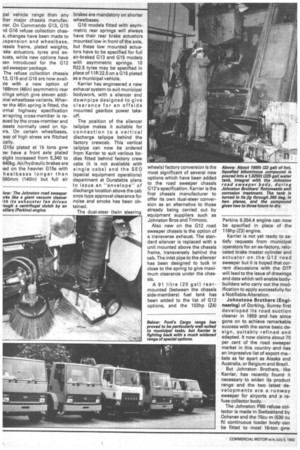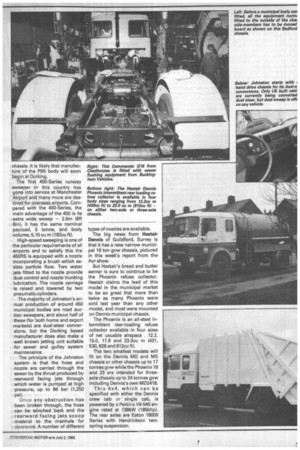Tried, tested and true rather than anything nevi
Page 43

Page 44

Page 45

If you've noticed an error in this article please click here to report it so we can fix it.
THE LIST of speakers and delegates at this year's Institute of Wastes Management conference makes it clear that there is no lack of engineering expertise in this sector of the industry. Yet anyone looking for signs of radical design change or innov tion among the vehicles al equipment on display at A would be disappointed.
Before indignant manufactt ers' representatives reach f their pens, I should make it de that this is simply an obso vation, not a criticism. The fact that municipal equipme operators do not welcome fi quent specification changes
less they can be convinced th will lead to improved efficienc, Well proven pieces of equ ment are the most successful
this business but that is not say that development work h come to a standstill.
It certainly has not at Karr Motors, which with its Duns
ble-built Dodge vehicles has long-standing record of SUCCE with both local authorities a privately owned refuse a waste disposal operators.
This year Karrier has probal made more significant refii merits and additions to its mu
pal vehicle range than any ther major chassis manufacKer. On Commando G13, G15 id G16 refuse collection chass, changes have been made to ispension and wheelbase, lassis frame, plated weights, -ake actuators, tyres and ex?Lists, while new options have ?en introduced for the G12 lad sweeper package.
The refuse collection chassis 13, G15 and G16 are now avail)le with a new option of 168mm (46in) asymmetric rear Kings which give eleven addimai wheelbase variants. Wher,er the 46in spring is fitted, the Kmal highway specification ar-spring cross-member is reaced by the cross-member and ;ssets normally used on tip?rs. On certain wheelbases,
• eas of high stress are flitched cal ly.
G15s plated at 15 tons gvw wv have a front axle plated eight increased from 5,340 to 440kg. Air/hydraulic brakes are ;ed on the heavier G15s with heelbases longer than 560mm (140in) but full air brakes are mandatory on shorter wheelbases.
G16 models fitted with asymmetric rear springs will always have their rear brake actuators mounted low in front of the axle, but these low mounted actuators have to be specified for full air-braked G13 and G15 models with asymmetric springs. 10 R22.5 tyres may be specified in place of 11R 22.5 on a G15 plated as a municipal vehicle.
Karrier has engineered a new exhaust system to suit municipal bodywork, with a silencer and downpipe designed to give clearance for an offside mounted gearbox power takeoff.
The position of the silencer tailpipe makes it suitable for connection to a vertical discharge tailpipe behind the factory crewcab. This vertical tailpipe can now be ordered from Karrier to suit various bodies fitted behind factory crew cabs (it is not available with single cabs) and the SE0 (special equipment operations) department at Dunstable plans to issue an "envelope" of discharge location above the cab once type approval clearance for noise and smoke has been obtained.
The dual-steer (twin steering wheels) factory conversion is the most significant of several new options which have been added to the road sweeper chassis G12's specification. Karrier is the first chassis manufacturer to offer its own dual-steer conversion as an alternative to those already being carried out by equipment suppliers such as Johnston Bros and Trimoco.
Also new on the G12 road sweeper chassis is the option of a transverse exhaust. The standard silencer is replaced with a unit mounted above the chassis frame, transversely behind the cab. The inlet pipe to the silencer has been designed to tuck in close to the spring to give maximum clearance under the chassis.
A 91 litre (20 gal) rearmounted (between the chassis side-members) fuel tank has been added to the list of G12 options, and the 102hp (Z4) Perkins 6.354.4 engine can now be specified in place of the 118hp (Z3) engine.
Karrier is not yet ready to satisfy requests from municipal operators for an ex-factory, relocated brake master cylinder and actuator on the G12 road sweeper but it is hoped that current discussions with the DTP will lead to the issue of drawings and data which will enable bodybuilders who carry out the modification to apply successfully for a Notifiable Alteration.
Johnstone Brothers (Engineering) of Dorking, Surrey first developed its road suction cleaner in 1959 and has since gone on to achieve remarkable success with the same basic design, suitably refined and adapted. It now claims about 70 per cent of the road sweeper market in this country and has an impressive list of export matkets as far apart as Alaska and Australia, or Belgium and Brazil.
But Johnston Brothers, like Karrier, has recently found it necessary to widen its product range and the two latest developments are a runway sweeper for airports and a refuse collector body.
The Johnston PB5 refuse collector is made in Switzerland by Ochsnep and the 15cu m (530 cu ft) continuous loader body can be fitted to most 16-ton gvw chassis. It is likely that manufacture of the PB5 body will soon begin at Dorking.
The first 450-Series runway sweeper in this country has gone into service at Manchester Airport and many more are destined for overseas airports. Compared with the 400-Series, the main advantage of the 450 is its extra wide sweep — 2.6m (8ft 6in), it has the same nominal payload, 5 tonne, and body volume, 5.15 cu m (182cu ft).
High-speed sweeping is one of the particular requirements of all airports and to satisfy this the 450RS is equipped with a nozzle incorporating a brush which assists particle flow. Two water jets fitted to the nozzle provide dust control and nozzle trunking lubrication. The nozzle carriage is raised and lowered by two pneumatic cylinders.
The majority of Johnston's annual production of around 450 municipal bodies are road suction sweepers, and about half of these (for both home and export markets) are dual-steer conversions, but the Dorking based manufacturer does also make a well known jetting unit suitable for sewer and gulley system maintenance.
The principle of the Johnston system is that the hose and nozzle are carried through the sewer by the thrust produced by rearward facing jets through which water is pumped at high pressure, up to 86 bar (1,250
psi).
tJr any obstruction has
been broken through, the hose can be winched back and the rearward facing jets scoop material to the manhole for clearance. A number of different
types of nozzles are available.
The big news from Hestair Dennis of Guildford, Surrey is that it has a new narrow municipal 16 ton gvw chassis, pictured in this week's report from the Ayr show.
But Hestair's bread and butter earner is sure to continue to be the Phoenix refuse collector. Hestair claims the lead of this model in the municipal market to be so great that more than twice as many Phoenix were sold last year than any other model, and most were mounted on Dennis municipal chassis.
The Phoenix is an all-steel intermittent rear-loading refuse collector available in four sizes of net usuable airspace . 12.2, 15.0, 17.8 and 23.0cu m (431, 530, 629 and 812cu ft).
The two smallest models will fit on the Dennis MD and MS chassis or other chassis up to 17 tonnes gvw while the Phoenix 18 and 23 are intended for threeaxle chassis up to 24 tonnes gvw including Dennis's own MD2418.
This 6x4, which can be specified with either the Dennis crew cab gr single cab, is powered by a Perkins V8-540 engine rated at 138kW (185bhp). The rear axles are Eaton 18000 Series with Hendrickson twospring suspension.




































































































